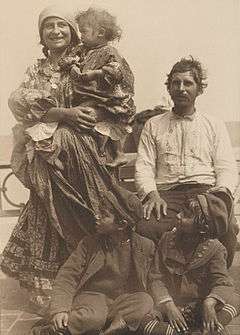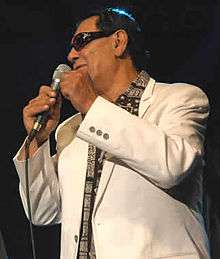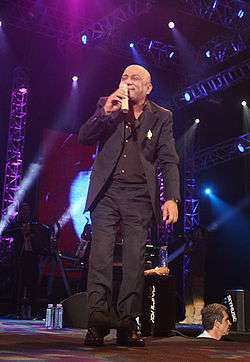Romani people in Serbia
| Total population | |
|---|---|
| (147,604 (2011)) | |
| Languages | |
| Romani, Serbian, Romanian, Hungarian, Albanian | |
| Religion | |
| Eastern Orthodox Christianity, Sunni Islam, Roman Catholic |
Romani people (Serbian: Роми/Romi) in Serbia, are the third largest ethnic group in Serbia, numbering 147,604 (2.1%) according to the 2011 census. Another name used for Roma in Serbia, often with a negative connotation, is Cigani (Цигани). Several migration waves of Romani to Serbia are recorded from Hungary, Romania, Turkey and Bosnia and Herzegovina. The Romani people are divided into numerous subgroups, with different, although related, Romani dialects and history. The community has produced several notable musicians. Adding to a very large indigenous Roma population in Serbia which counts among the largest in the Balkans, anywhere between 46,000[1] to 97,000[2] Roma are internally displaced from Kosovo after 1999.
Subgroups
Main sub-groups include "Turkish Gypsies" (Turski Cigani), "White Gypsies" (Beli Cigani), "Wallachian Gypsies" (Vlaški Cigani) and "Hungarian Gypsies" (Mađarski Cigani), as studied by scholar Tihomir Đorđević (1868–1944).[3]
- Wallachian Roma. Migrated from Romania, through Banat.[4] They have converted to Eastern Orthodoxy and mostly speak Serbian fluently.[5] They are assumed to be the largest Romani group in the country.[5] They are related to the Turkish Roma.[4] T. Đorđević noted several sub-groups.[6]
- Turkish Roma, also known as Arlia. Migrated from Turkey.[7] At the beginning of the 19th century the Turkish Roma lived mainly in southeastern Serbia, in what was the Sanjak of Niš.[8] The Serbian government attempted to force Orthodoxy on them after the conquest of the sanjak (1878), but without particular success.[8] They are mainly Muslims.[8] T. Đorđević noted an internal division between old settlers and new settlers, who had differing traditions, speech, family organization and occupations.[3]
- "White Gypsies", arrived later than other Romani groups, at the end of the 19th century,[4] from Bosnia and Herzegovina.[7] Permanently settled mostly in towns.[4] Serbian-speakers.[4] Sub-group of Turkish Roma.[4] T. Đorđević noted them as living in Podrinje and Mačva, being Muslim, and that they had lost their language.[3]
- Hungarian Roma.
History

Romani, or "gypsies", arrived in Serbia in several waves.[9] The first reference to gypsies in Serbia is found in a 1348 document, by which Serbian emperor Stefan Dušan donated some gypsy slaves to a monastery in Prizren (now in Kosovo).[10] In the 15th century, Romani migrations from Hungary are mentioned.[9]
In 1927, a Serbian-Romani humanitarian organization was founded.[11] In 1928, a Romani singing society was founded in Niš.[11] In 1932, a Romani football club was founded.[11] In 1935, a Belgrade student established the first Romani magazine, Romani Lil, and in the same year a Belgrade Romani association was founded.[11] In 1938, an educational organization of Yugoslav Romani was founded.[11]
Culture
The Romani people in Central Serbia are predominantly Serbian Orthodox but a minority of Muslim Roma exists (mostly Roma refugees from Kosovo), mainly in the southern Serbia.
Romani people in multi-ethnic Vojvodina are integrated with other ethnic groups, especially with Serbs, Romanians and Hungarians. For this reason, depending of the group with which they are integrated, Romani are usually referred to as Serbian Romani, Romanian Romani, Hungarian Romani, etc.
The majority of Romani people are Christian and a minority are Muslim. Đurđevdan or Ederlezi is a traditional festivity of Roma in Serbia. They speak mainly Romani and Serbian. Some also speak the language of other people they have been influenced by: Romanian, Hungarian or Albanian. In October 2005 the first text on the grammar of the Romani language in Serbia was published by linguist Rajko Đurić, titled "Gramatika e Rromane čhibaki - Граматика ромског језика".
Discrimination
A large number of Serbian Roma people live in slums, and so-called "cardboard cities". Many Roma children never go to school. Instead they are often used as beggars, occasionally even mutilated in order to earn more money. On 3 April 2009, a group of Romani people who had been living in an unlawful settlement in Novi Beograd were evicted on the orders of the mayor of Belgrade. According to the press, bulldozers accompanied by police officers arrived to clear the site early in the morning before the formal eviction notice was presented to the community. The makeshift dwellings were torn apart while their former occupants watched. The site was cleared in order to make way for an access road to the site of the 2009 Student Games, to be held in Belgrade later this year. Temporary alternative accommodation in the form of containers had apparently been provided by the Mayor of Belgrade, but some 50 residents of the suburb where they had been located attempted to set fire to three of the containers. Many of the evicted Roma have spent five nights sleeping in the open in the absence of any alternative accommodation.[12]
There has been incidents of FK Rad hooligan (and skinhead) attacks on Roma, such as the death of thirteen-year-old Dušan Jovanović (1997),[13] and also the death of actor Dragan Maksimović, who was assumed to be Romani (2001).[14]
Demographics
There are 147,604 Romani people in Serbia, but unofficial estimates put the figure up to 450,000-500,000.[15] Between 23,000-100,000 Serbian Roma are internally displaced persons from Kosovo.[16][17]
| Census | Population | Notes |
|---|---|---|
| 1866 | 24,607 | |
| 1895 | 46,000 | |
| 1921 | 34,919 | Analysis of census (including SR Serbia and SR Macedonia).[6] |
| 1948 | 52,181 | |
| 1953 | 58,800 | |
| 1961 | 9,826 | |
| 1971 | 49,894 | |
| 1981 | 110,959 | |
| 1991 | 94,492 | |
| 2002 | 108,193 | |
| 2011 | 147,604 | |
Political parties
Notable people
 |  |
- Rajko Đurić, professor, journalist, and politician.
- Trifun Dimić, romologist.
- Srđan Šajn, politician.
- Boban Marković, trumpeter.
- Bakija Bakić, trumpeter.
- Fejat Sejdić, trumpeter.
- Ekrem Sajdić, trumpeter.
- Elvis Ajdinović, trumpeter.
- Janika Balaž, tamburitza musician.
- Šaban Bajramović, folk and jazz singer.
- Džej Ramadanovski, folk singer.
- Boža Nikolić, folk singer.
- Sinan Sakić, folk singer.
- Ljuba Aličić, folk singer.
- Usnija Redžepova, folk singer.
- Predrag Luka, footballer.
- Dejan Osmanović, footballer.
- Ahmed Ademović, soldier.
See also
References
- ↑ http://www.osce.org/odihr/39623?download=true
- ↑ Relief, UN (2010). "Roma in Serbia (excluding Kosovo) on 1st January 2009" (PDF). UN Relief. 8 (1).
- 1 2 3 IFDT 2005, p. 21.
- 1 2 3 4 5 6 Vlahović 2004, p. 67.
- 1 2 Human Rights and Collective Identity: Serbia 2004. Helsinki Committee for Human Rights in Serbia. 1 January 2005. ISBN 978-86-7208-106-0.
- 1 2 IFDT 2005, p. 22.
- 1 2 Sait Balić (1989). Džanglimasko anglimasqo simpozium I Romani ćhib thaj kultura. Institut za proučavanje nacionalnih odnosa--Sarajevo. p. 53.
- 1 2 3 Adrian Marsh; Elin Strand (22 August 2006). Gypsies and the Problem of Identities: Contextual, Constructed and Contested. Swedish Research Institute in Istanbul. p. 180. ISBN 978-91-86884-17-8.
- 1 2 Vlahović 2004, p. 66.
- ↑ Djordjević , T.R. (1924). Iz Srbije Kneza Milosa. Stanovnistvo—naselja. Beograd: Geca Kon.
- 1 2 3 4 5 IFDT 2005, p. 23.
- ↑ https://www.amnesty.org/en/news-and-updates/feature-stories/europes-roma-community-still-facing-massive-discrimination-20090408#serbia. Missing or empty
|title=(help) - ↑ http://www.e-novine.com/mobile/srbija/srbija-tema/73056-Smrt-dravi-nasilja.html. Missing or empty
|title=(help) - ↑ http://www.opustise.rs/tracevi/14-godina-od-smrti-dragan-maksimovic-maksa-zasluzio-da-dobije-svoju-ulicu/. Missing or empty
|title=(help) - ↑ (World Bank, 2005b; Antic, 2005)
- ↑ http://www.osce.org/odihr/39623?download=true
- ↑ Relief, UN (2010). "Roma in Serbia (excluding Kosovo) on 1st January 2009" (PDF). UN Relief. 8 (1).
Sources
- Vlahović, Petar (2004). Serbia: the country, people, life, customs. Ethnographic Museum. ISBN 978-86-7891-031-9.
- IFDT (2005). Umetnost preživljavanja: gde i kako žive Romi u Srbiji. IFDT. ISBN 978-86-17-13148-5.
Further reading
- Rajko Đurić; Václav Havel (2006). Istorija Roma: (pre i posle Aušvica). Politika. ISBN 978-86-7607-084-8.
- Biljana Sikimić (2005). Banjaši na Balkanu: identitet etničke zajednice. Srpska akademija nauka i umetnosti, Balkanološki Institut.
- Dragoljub Acković (2009). Romi u Beogradu: istorija, kultura i tradicija Roma u Beogradu od naseljavanja do kraja XX veka. Rominterpres. ISBN 978-86-7561-095-3.
- Zlata Vuksanović-Macura; Vladimir Macura (2007). Stanovanje i naselja Roma u jugoistočnoj Evropi: prikaz stanja i napretka u Srbiji. Društvo za Unapređivanje Romskih Naselja. ISBN 978-86-904327-2-1.
- Roma in Serbia. Fond za humanitarno pravo. 2003. ISBN 978-86-82599-45-6.
